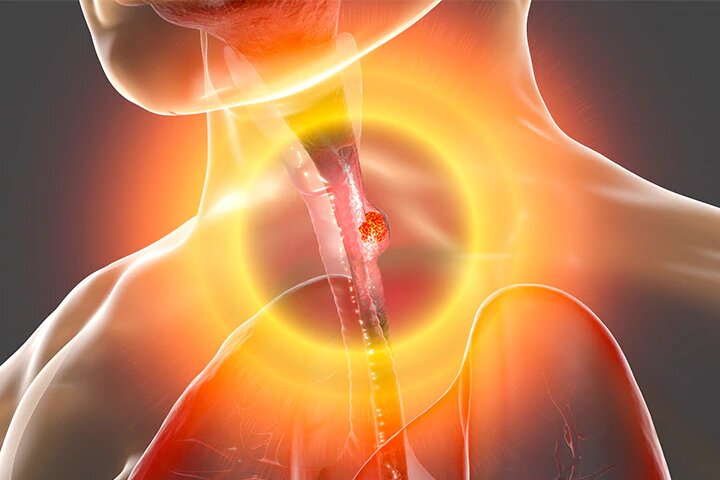esophageal cancer
Type of esophageal cancer
 The esophagus is a muscular tube measuring 20-25 cm (8-10 inches) long and 2-3 cm (0.75-1.25 inches) wide which serves as a conduit to move food and drink from the mouth to the stomach. Two major types of esophageal cancers exist, as follows:
The esophagus is a muscular tube measuring 20-25 cm (8-10 inches) long and 2-3 cm (0.75-1.25 inches) wide which serves as a conduit to move food and drink from the mouth to the stomach. Two major types of esophageal cancers exist, as follows:
Squamous cell carcinoma arises from the surface (epithelial) cells that line the skin. 'esophagus.
Adenocarcinoma originates in the esophageal glands or in a segment of the Barrett's esophagus.
Although tumors can occur anywhere in the esophagus, adenocarcinoma occurs more frequently in the lower part while squamous cell carcinoma occurs more frequently in the upper part of the esophagus. 'esophagus.
Other types of tumors are rarely observed ( lymphoma , melanoma or sarcoma).
What is esophageal cancer?
Esophageal cancer is a disease where the tissues of the tube-like structure that connects the throat to the stomach (esophagus) become malignant (cancer).
Cancers of the esophagus may be generally referred to as 'esophageal cancer' or more specifically referred to in connection with their location and type as 'gastroesophageal junction adenocarcinoma' (meaning an adenoma located where stomach and esophagus are connected).
Causes of cancer of the esophagus
The exact cause(s) of this condition is not known. However, researchers suspect that certain risk factors may cause DNA damage in cells that can lead to disease.
How to treat esophageal cancer?
Treatment for esophageal cancer depends on test results and your underlying medical condition.
People with advanced heart or lung disease may not be candidates for aggressive treatment.
In many cases, esophageal cancer has advanced too far for available treatment to function.
In these cases, the doctor considers the following palliative procedures:
Placing a metal or plastic tube (stent) into the esophagus to allow passage of food and liquids.
Radiotherapy.
Photodynamic therapy (tissues are chemically sensitized and then treated with an internally focused light source).
Enlargement (careful dilation) of the esophagus or laser tumor destruction of the esophagus.
Other palliative procedures (e.g. electrocautery, laser ablation).
Pain management.
Manage complications such as bleeding.
Is there surgery for esophageal cancer?
In otherwise healthy people with localized disease, surgery may offer the best chance of long-term survival.
Surgery involves removing the diseased part of the esophagus and connecting the remaining part to the stomach (resection).
Preoperative chemotherapy and radiation therapy often accompany surgery.
Studies currently underway will determine if combined chemotherapy and radiation therapy without surgery are as effective as surgery to prolong long-term survival. The current results give contradictory opinions. The search continues.